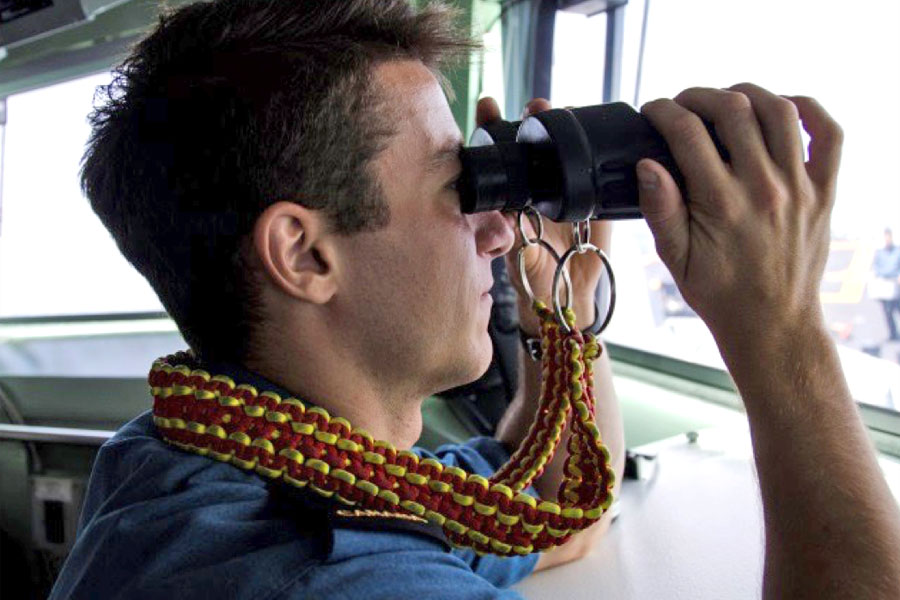Tiddly rope work
By Lookout on Jul 19, 2017 with Comments 0

Ordinary Seaman Olivier Gingras uses binoculars with a decorative strap knotted by the Deck Department. Photo by Royal Canadian Navy Public Affairs
SLt S.M. Anderson, HMCS Ottawa ~
The colourful yellow, blue and white lines hang from a hook on the deck head in the small room under the flight deck of HMCS Ottawa.
The lines and the sailor working on them, Ordinary Seaman Olivier Gingras, sway slightly with the movements of the ship as he creates a new binocular strap for the ship’s bridge. His fingers moving dexterously as he plaits the lines into a colourful, intricate whole, turning a simple binocular strap into a symbol of the history and tradition of the Royal Canadian Navy.
Naval rope work is as much a symbol of the navy as an anchor or the naval crown. It is a mixture of unique knots and braids that form complex patterns and are used to cover items throughout the ship.
Functional rope work can be used to reinforce hawsers or keep lines from chafing, and is a necessary skill when out at sea, far from replacement ropes.
Decorative rope work with intricate patterns and colours that cover railings or bell pulls lends to the beauty and pride of a ship, and is an increasingly rare skill for modern sailors.
“Rope work has to do with pride on an individual level,” says Chief Petty Officer Second Class John Kranz, Chief Boatswains Mate. “It identifies the ship’s colours as well as how skilled the Deck department is.”
From the intricately patterned binocular straps on the bridge to the elaborate knot work on the ship’s paddles that hang in each of the messes, it is clear the art of rope work is alive and well in Ottawa.
Ornamental rope work or “tiddly rope work” as the boatswains call it, is a tradition dating back centuries. In the days of Vice Admiral Nelson, a sailing ship was judged on the decorative rope work on railings, oars and bells. The pride of a sailor in his rope work also emphasized pride in the ship and the excellence of her crew.
“Rope work is a lost art among boatswains,” says CPO2 Kranz. “I teach rope work on board Ottawa in order to allow the sailors to express themselves and show their artistic side. Rope work gives the sailors pride in what they do and showcases their hard work to the ship and the wider community.”
In the Deck Department Office, Able Seaman Timothy Bee is eager to display his latest project, a paddle covered in ornamental rope work in the colours of Ottawa: red, black and white. The intricate knot work that covers the handle is a testament to the patience and pride of the boatswain. Ordinary Seaman Brandyn-Alan Anderson, standing at the stern rail as life buoy sentry, reflects on his experience learning ornamental rope work.
“Rope work is a great way to pass the long hours at sea. It connects me to the traditions of the navy. This is my first sail and it has been an amazing experience to learn traditional rope work. It’s just my opinion, but HMCS Ottawa is the best ship in the fleet.”
Ottawa has been deployed in the Indo-Asia-Pacific for the last five months on Poseidon Cutlass 17, exercising with partner navies and building relationships across the region. In a few weeks, Ottawa will be homeward bound for Esquimalt and the sailors will return to their families and friends; but the intricate rope work created by the boatswains during the deployment will remain on the ship to inspire new sailors coming on board.
“Rope work is a way that a sailor can leave a piece of themselves with the ship. History and tradition are important in the Royal Canadian Navy, and I mentor my subordinates the lost art of rope work hoping they will pass it on to their junior sailors someday and the tradition will continue,” says CPO2 Kranz.
Filed Under: Top Stories
About the Author:





